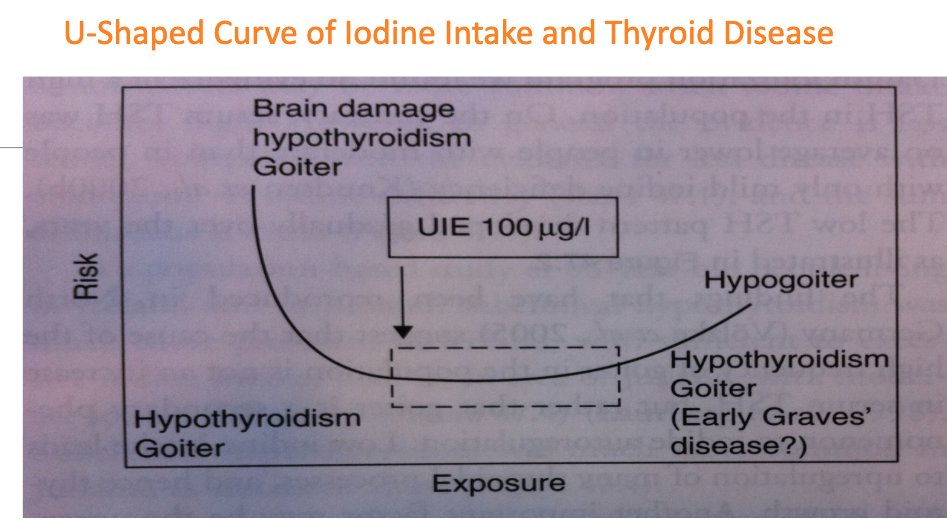You may have come under the impression that iodine is either toxic and you should not have any in your system, or it’s great and the sky’s the limit. But, there is a healthy range that you can consider to learn just how much iodine is best for you.
What I want you to know is that a good range does exist when it comes to your iodine intake. It can be a narrow range, but I want to talk about those ranges and how it looks (Read: How much iodine do you need for thyroid disease?).

The Importance of Selenium
For starters, everyone has an even narrower iodine range when they are deficient in selenium. This does not mean that a ton of selenium is good, either. But it does mean that if your body is lacking in the ability to make do with different amounts of iodine.
Key Insight: A great way to start understanding your ideal iodine range is ensuring that you have adequate selenium in your system.
How do you get more selenium in your diet? Ideally, that would look like 50 – 100 micrograms per day. Supplements don’t absorb that great, but at such small volumes, they should be able to work for you.
I would not exceed that recommendation, though. There is data that suggests that more than 400 micrograms of selenium can be detrimental to thyroid function. Some is good, more is not better, and a fair amount of foods have it.
If you are paleo, a lot of shellfish have selenium. If you are vegan, whole grains are a fantastic option. In any case, even a handful of brazil nuts a week can add the right amount of selenium to your diet.
Bottom Line: Not too little, and not too much, but it’s a great idea to include selenium with various food items. As well as a multivitamin.
Understanding Iodine Ranges
The broadest range is the one that is deemed reasonably safe by the World Health Organization (WHO). They have said that if you do not have thyroid disease, or are not at risk for it, you can get by on a pretty good leeway of iodine without worry (Read: Iodine the most misunderstood supplement for your thyroid).
Key Insight: The argument is that a pretty good leeway of iodine would be between 100 – 1100 micrograms.
They base that on the results of lots of population data that have fortified their iodine intake by adding it to salt or to drinking water. Whenever it goes beyond that, though, is when people start to develop issues.1
For those who are looking to prevent thyroid disease, there are two distinct facets to this answer:
- How much do you get
- How does your intake change
The simplest here is just how much you get. Per the Conference of Iodine Handbook, which is a book that distills thousands of human studies to a single graph (which you can see below).

They showed that there is this distinct u-shaped curve, meaning that both low and high levels of iodine both engender thyroid issues.
Key Insight: Ultimately, we need some iodine and a sweet spot definitely exists. That sweet spot is somewhere between 100 – 300 micrograms.
Now, the first thing you will likely notice is that 100 – 300 micrograms is not a broad range at all. In fact, it is a rather narrow amount.
The other wrinkle here, though, is that there have been papers showing that populations whose intake changed still could have an onset of thyroid disease because of the change.

Case in point: Denmark. They are one of the more recent nations to add in iodine fortification into their drinking water (in the year 2000).
In the following decade and a half, they had much higher rates of autoimmune thyroid issues. Even though they did it right, the change itself had a large effect on the number of people who encountered thyroid issues.
Bottom Line: The iodine wrinkle that you do not hear about is that there are good amounts, but fluctuations in amounts matter, too.
Iodine In Food
I have been doing a lot of reading on assays of iodine in foodstuffs. I have even been talking with folks from the USDA and FDA about their tracking of this data.
The interesting thing is that iodine can vary dramatically in different foods. So, for instance, milk or bread presents a fairly substantial range of iodine
Key Insight: Sometimes the same food might have 10 micrograms or 600 micrograms. It is not uncommon at all.
This means that if you ate a collection of foods that were all on the high-end of the iodine range, you could, unfortunately, uncover thyroid issues that were not present beforehand.
Unfortunately, this is doubly true for those on thyroid treatment. This is because all thyroid treatments contain substantial amounts of iodine (Read: What supplements are important to take what nutrients not to take).
Maximizing Your Odds
What if you want to maximize your odds of reversing thyroid disease with iodine? Well, a large study performed in Korea, showed that targeting less than 100 micrograms for a period of 3 – 6 months has a hugely beneficial effect on those with Hashimoto’s disease.
In fact, in the first 3 months 78.3% of the patients who were treated with a low-iodine diet had their TSH go from an average of 14 down to 3. In a perfect world, I’d like to go lower than that, but it sure is better than 14.2
Of the nonresponders, all but 1 saw a trend of TSH reduction short of euthyroidism which may have continued. That same person saw a progression of hypothyroidism.
So, how long would you wish to do something like that? The main way that you go to that low a level of iodine intake, is by:
- Avoiding all pills that contain iodine
- Limiting the highest food sources
What are the highest food sources? They include:
- Dairy
- Commercial breads
- Seafoods
When it comes to limiting your dairy and seafood intake, I do question how wise it might be to limit them many months out. Eventually, I do not think that the benefits would outweigh the negatives.
Pregnancy and Iodine Intake

During pregnancy, your body does need more iodine because the baby needs some as well. While infants do not absorb thyroid hormone, they do absorb iodine.
This means that, early on in development, they are making their own thyroid hormone (and not getting it from mom). This means that they need some iodine to effectively do so.
Key Insight: The high end of the safe range, 150 – 300 micrograms, is a good idea for a pregnant woman to get from her iodine intake.
How Much Iodine Are You Getting?
After all this talk about safe iodine levels, how are you supposed to know how much iodine you are currently getting?
The part that bums me out is that there are really no accurate tests for iodine. I am not saying that there are no tests at all, but I truly wish that there was a test that accurately shows how much iodine is truly in your system.
Your iodine fluctuates so much based on the iodine in your:
- Blood
- Urine
- Hair
- Feces
Ultimately, you would require such a large number of readings to really make sense of your exact iodine load at one point in time.
Imagine that you wanted to measure someone’s exact height. As you were measuring them, though, they happened to be in a yoga class.

Sometimes the person is standing up tall, crouching really low, or even lying on the floor. Yet, there you are, continuing to measure the distance between their head and the floor.
If you got enough readings, you might know enough to say “only the high readings count.” That said, you’d need a whole lot of measurements to know which are the highest.
It is the same way with iodine. Your levels vary so much, and the closest test currently is a 24-hour urinary iodine test.
Bottom Line: A lot of these aforementioned tests are perfectly useful when you are studying populations, 500 or 1000 people, but that does not help gain insight into any one particular person.
The Ideal Iodine Test
As I mentioned, a 24-hour urinary iodine test is typically the most effective option currently out there. This means you have to measure over 250 samples, on one person, to be within 90% accuracy.
That would mean collecting all of your urine over the course of nine months! That sounds a bit extreme, no? There is a blood marker called thyroglobulin, though, and it is inversely related to iodine status.
It is a somewhat accurate marker, but the big disconnect is that it is not useful for those who have thyroid disease – simply because thyroid disease skews thyroglobulin.
Bottom Line: Unfortunately, the ideal iodine test for someone with thyroid disease does not currently exist. Thankfully, though, you can be more aware of it.
Action Steps: Your Iodine Intake
So, in order to be more aware of our iodine intake, we have put together a super helpful calculator (Click Here) to help you make sense of just how much iodine you might be getting into your system on a daily basis.
This test will take a look at:
- Your Thyroid Medications
- Various Supplements
- Your Food Intake (everything from seafood to salt)
We will compile all of that data, and you will get a number to help you make better sense of your iodine load – and what you could be doing to mitigate it.
Getting your iodine levels right can be one of the biggest solutions out there for reversing or radically improving thyroid disease. Want to know where you stand with your thyroid? Take the Thyroid Quiz (Click Here) today to learn more.
Resources
1 – https://www.nap.edu/read/10026/chapter/2#22
2 – https://doi.org/10.3349/ymj.2003.44.2.227

1. Schedule a Thyroid Second Opinion with me, Dr. C, Click Here for Details
2. Download and use my Favorite Recipes Cookbook Here
3. Check out my podcast Medical Myths, Legends, and Fairytales Here
Dr. Alan Glen Christianson (Dr. C) is a Naturopathic Endocrinologist and the author of The NY Times bestselling Adrenal Reset Diet, The Metabolism Reset Diet and The Thyroid Reset Diet.
Dr. C’s gift for figuring out what really works has helped hundreds of thousands of people reverse thyroid disease, lose weight, diabetes, and regain energy. Learn more about the surprising story that started his quest.


